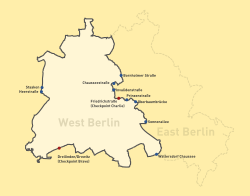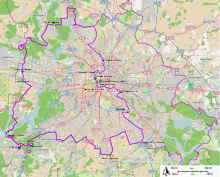
Back Berlynse Muur Afrikaans Berliner Mauer ALS የበርሊን ግድግዳ Amharic Muro de Berlín AN جدار برلين Arabic سور برلين ARZ Muriu de Berlín AST Berlin divarı Azerbaijani Берлин диуары Bashkir Берлінская сцяна Byelorussian
| The Berlin Wall | |
|---|---|
 From the West Berlin side, Berlin Wall graffiti art in 1986. The Wall's "death strip", on the east side of the Wall, here follows the curve of the Luisenstadt Canal (filled in 1932). | |
 The Wall and its checkpoints | |
| General information | |
| Type | Wall |
| Country |
|
| Coordinates | 52°30′16″N 13°26′28″E / 52.50444°N 13.44111°E |
| Construction started | 13 August 1961 |
| Demolished | 9 November 1989 – 1994[1] |
| Dimensions | |
| Other dimensions |
|
| Technical details | |
| Size | 155 km (96.3 mi) |
| ||
|---|---|---|
| First Secretary of the Socialist Unity Party | ||
|
|
||
   |
||
| Eastern Bloc |
|---|
 |


The Berlin Wall (German: Berliner Mauer, pronounced [bɛʁˌliːnɐ ˈmaʊɐ] ) was a guarded concrete barrier that encircled West Berlin from 1961 to 1989, separating it from East Berlin and the German Democratic Republic (GDR; East Germany).[a][1][3] Construction of the Berlin Wall was commenced by the government of the GDR on 13 August 1961. It included guard towers placed along large concrete walls,[4] accompanied by a wide area (later known as the "death strip") that contained anti-vehicle trenches, beds of nails and other defenses. The primary intention for the Wall's construction was to prevent East German citizens from fleeing to the West.[5]
The Soviet Bloc propaganda portrayed the Wall as protecting its population from "fascist elements conspiring to prevent the will of the people" from building a communist state in the GDR. The authorities officially referred to the Berlin Wall as the Anti-Fascist Protection Rampart (German: Antifaschistischer Schutzwall, pronounced [antifaˌʃɪstɪʃɐ ˈʃʊtsval] ). Conversely, West Berlin's city government sometimes referred to it as the "Wall of Shame", a term coined by mayor Willy Brandt in reference to the Wall's restriction on freedom of movement.[6] Along with the separate and much longer inner German border, which demarcated the border between East and West Germany, it came to symbolize physically the Iron Curtain that separated the Western Bloc and Soviet satellite states of the Eastern Bloc during the Cold War.[7]
Before the Wall's erection, 3.5 million East Germans circumvented Eastern Bloc emigration restrictions and defected from the GDR, many by crossing over the border from East Berlin into West Berlin; from there they could then travel to West Germany and to other Western European countries. Between 1961 and 1989, the deadly force associated with the Wall prevented almost all such emigration.[8] During this period, over 100,000[9] people attempted to escape, and over 5,000 people succeeded in escaping over the Wall, with an estimated death toll of those murdered by East German authorities ranging from 136[10] to more than 200[7][11] in and around Berlin.
In 1989, a series of revolutions in nearby Eastern Bloc countries (Poland and Hungary in particular) and the events of the "Pan-European Picnic" set in motion a peaceful development during which the Iron Curtain largely broke, rulers in the East came under public pressure to cease their repressive policies.[12][13][14] After several weeks of civil unrest, the East German government announced on 9 November 1989 that all GDR citizens could visit the FRG and West Berlin. Crowds of East Germans crossed and climbed onto the Wall, joined by West Germans on the other side, and souvenir hunters chipped away parts of the Wall over the next few weeks.[7] The Brandenburg Gate, a few meters from the Berlin Wall, reopened on 22 December 1989, with demolition of the Wall beginning on 13 June 1990 and concluding in 1994.[1] The fall of the Berlin Wall paved the way for German reunification, which formally took place on 3 October 1990.[7]
- ^ a b c "Untangling 5 myths about the Berlin Wall". Chicago Tribune. 31 October 2014. Archived from the original on 20 April 2019. Retrieved 1 November 2014.
- ^ Piotrowicz, Ryszard W.; Blay, Sam (1997). The unification of Germany in international and domestic law. Rodopi. p. 42. ISBN 90-5183-755-0. OCLC 36437948.
- ^ Video: Berlin, 1961/08/31. Universal Newsreel. 1961. Retrieved 20 February 2012.
- ^ Marck, Jack (October 2006). "Over the Wall: A Once-in-a-Lifetime Experience". American Heritage. Archived from the original on 29 August 2008.
- ^ "Berlin Wall". Encyclopaedia Britannica. 23 January 2024.
- ^ "Berlin Wall: Five things you might not know". The Telegraph. 12 August 2011. Archived from the original on 10 January 2022. Retrieved 22 May 2017.
- ^ a b c d "Berlin Wall Fast Facts". CNN. 16 September 2013. Archived from the original on 13 November 2019. Retrieved 9 April 2019.
- ^ "Freedom!". Time. 20 November 1989. Archived from the original on 21 November 2007. Retrieved 9 November 2009.
- ^ "Victims of the Wall". www.berlin.de. 19 August 2020. Archived from the original on 9 December 2021. Retrieved 9 December 2021.
- ^ Cite error: The named reference
Chronikwas invoked but never defined (see the help page). - ^ Cite error: The named reference
contemporary researchwas invoked but never defined (see the help page). - ^ Hilde Szabo: Die Berliner Mauer begann im Burgenland zu bröckeln (The Berlin Wall began to crumble in Burgenland – German), in Wiener Zeitung 16 August 1999; Otmar Lahodynsky: Paneuropäisches Picknick: Die Generalprobe für den Mauerfall (Pan-European picnic: the dress rehearsal for the fall of the Berlin Wall – German), in: Profil 9 August 2014.
- ^ Thomas Roser: DDR-Massenflucht: Ein Picknick hebt die Welt aus den Angeln (German – Mass exodus of the GDR: A picnic clears the world) in: Die Presse 16 August 2018.
- ^ Der 19. August 1989 war ein Test für Gorbatschows" (German – August 19, 1989 was a test for Gorbachev), in: FAZ 19 August 2009.
Cite error: There are <ref group=lower-alpha> tags or {{efn}} templates on this page, but the references will not show without a {{reflist|group=lower-alpha}} template or {{notelist}} template (see the help page).
